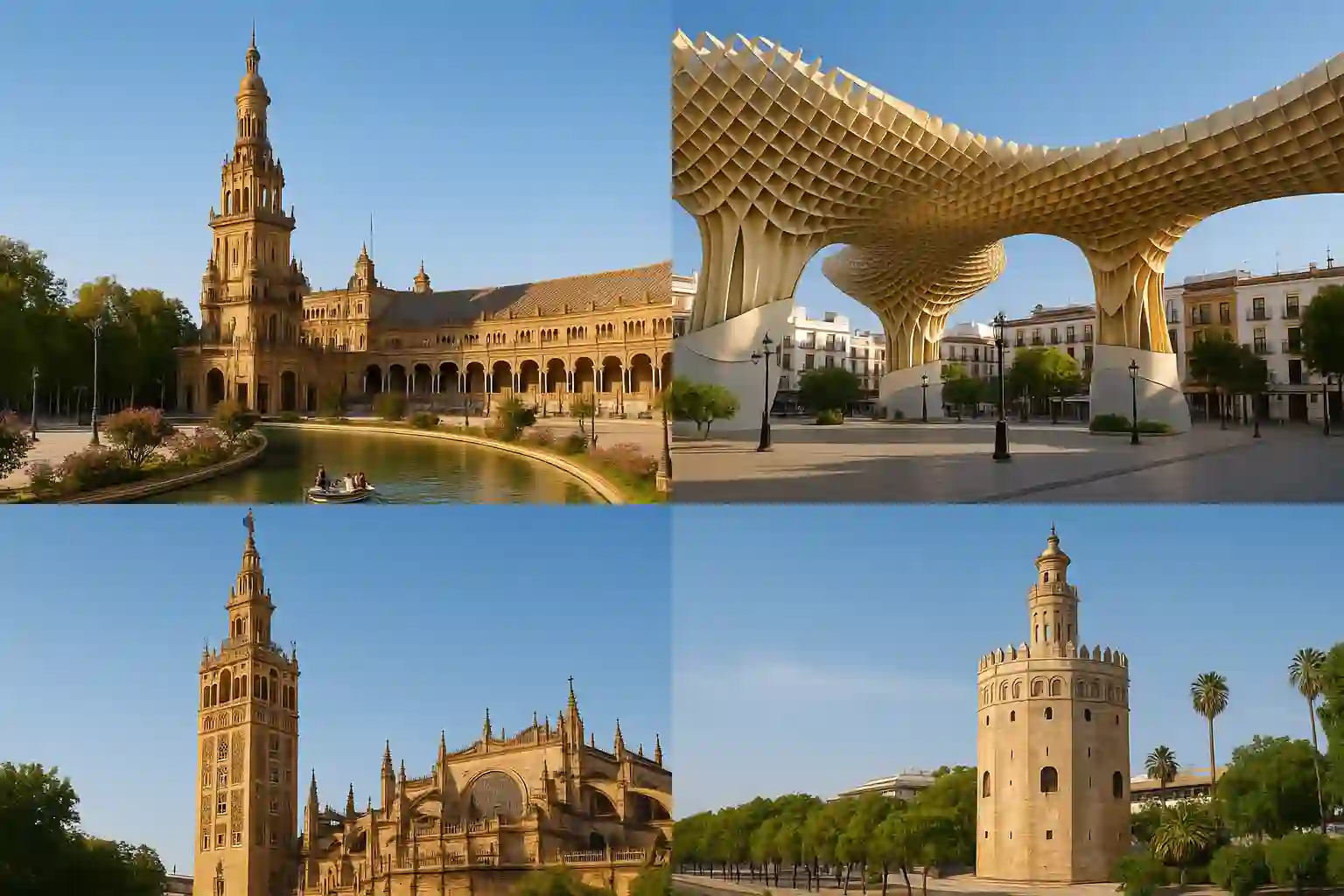Seville – Landmarks & Sights: What to See First

Quick Picks (First-Timer Priorities)
- Cathedral & La Giralda · Go at opening for emptier naves; climb the ramped tower for city-wide views without steps.
- Royal Alcázar · Mudéjar patios, whispering fountains, lush gardens. Pre-book morning slots; linger in the Jardín de la Danza.
- Palacio de las Dueñas · Noble residence with intimate courtyards and orange trees—a quieter masterpiece between headline sites.
- Plaza de España & Parque María Luisa · Blue-and-amber tilework, arcades and rowing canal; best in late afternoon light.
- Santa Cruz · Slow strolls through narrow lanes and tiled courtyards—visit after 6 pm when shade and ambience peak.
- Las Setas (Metropol Parasol) · Sunset walkway for skyline curves; the archaeology museum below is a quick, cool stop.
- Bullring Tour (Plaza de Toros) · Historic arena, museum and riverfront setting—combine with a Triana stroll.
How to Sequence Your Day
- Morning (cool & calm) · Cathedral & La Giralda → coffee near Plaza del Cabildo → Royal Alcázar garden time.
- Midday (shade & indoors) · Archivo de Indias or ceramics ateliers in Triana; long lunch, short siesta.
- Golden hour · Plaza de España tiles glow; stroll Parque María Luisa’s shaded avenues.
- Evening · Tapas hop in Santa Cruz or Triana; finish at Metropol Parasol (Las Setas) walkway for night views.
- Bonus half-day · Roman city of Itálica (nearby) for amphitheatre and mosaics; pair with riverside walk and the Nao Vigía “El Globo de Sevilla”.
Insider Tips
- Heat strategy · From late May to September, plan outdoors 8–11 am & after 6 pm; keep museums for 1–5 pm.
- Tickets · Book Alcázar & Cathedral online; timed entries reduce queues dramatically.
- Photo windows · Plaza de España tiles read best within 90 minutes of sunset; Giralda views are clearest 9–10 am.
- Ceramics · For authentic pieces, look for small workshops on Triana side streets rather than riverfront souvenir rows.
- Flamenco · Choose an intimate tablao with live guitar and cante; late slots feel less tour-paced.
When to Go
- Mar–Apr · Orange blossom season; Semana Santa crowds but unique processions and ambience.
- May–Jun · Long days, warm evenings; Feria de Abril (dates vary) brings traditional dress, horses and casetas.
- Jul–Aug · Very hot; slow itineraries with siesta, evening sightseeing and late dinners.
- Sep–Oct · Sweet spot of softer light and manageable temps; great for park time and river walks.
- Nov–Feb · Mild, quieter, good value; shorter opening hours but easy landmark access.
Getting Around
Old town is walkable; wear cushioned shoes for cobbles. Trams and buses cover longer hops; taxis and ride-hailing are plentiful at night. Cycling is pleasant along the river paths.
Suggested 2-Day Plan
Day 1 · Cathedral, Alcázar, Santa Cruz
Early Cathedral & La Giralda, coffee at a shaded arcade, timed Alcázar entry with unhurried garden pause. Late afternoon Plaza de España and Parque María Luisa; evening tapas in Santa Cruz.
Day 2 · Triana, River, Metropol Parasol
Morning Triana ceramics and market tastings, riverside walk to the bullfighting museum on the Plaza de Toros (Bullring Tour). Siesta, then Setas walkway for sunset and a final tapas round.
Book Here
Frequently Asked Questions
Do I need to book the Alcázar and Cathedral?
Yes, pre-booking saves time—choose early slots to enjoy quieter patios and naves.
What’s the best time for Plaza de España photos?
Within 60–90 minutes before sunset when the tiles glow and crowds thin.
Where should I stay for first visits?
Historic centre for walkability (Cathedral/Santa Cruz), or Triana for local vibes and river sunsets.
Is Seville manageable in summer heat?
Yes with a smart schedule: mornings & evenings outdoors, midday museum time, long lunches and siestas.
Where do I start planning on MundoDele?
Use the Travel Hub for routes and tours, the Culture Hub for festivals & customs, and Business Spanish Lessons if you’re here for work.
